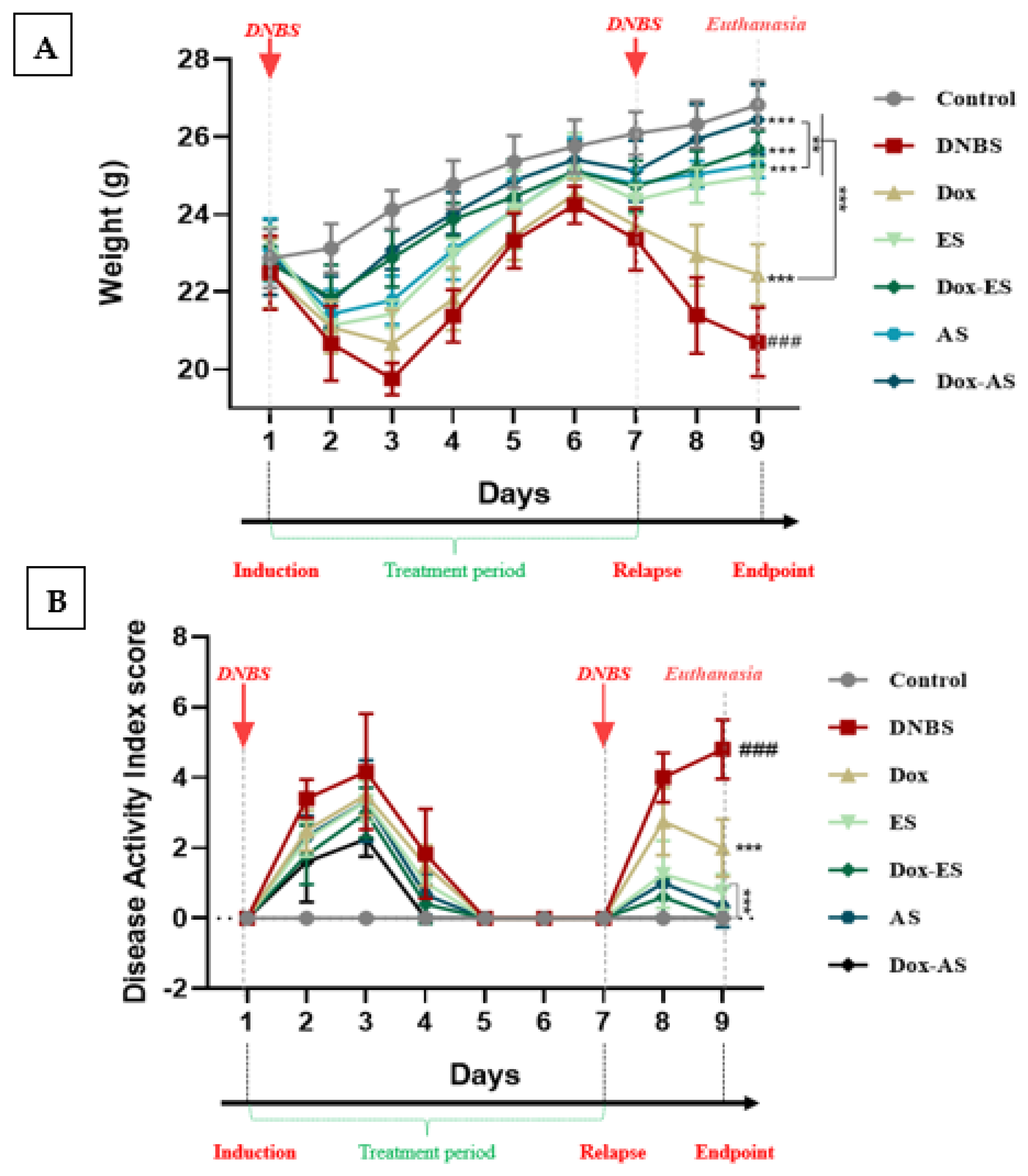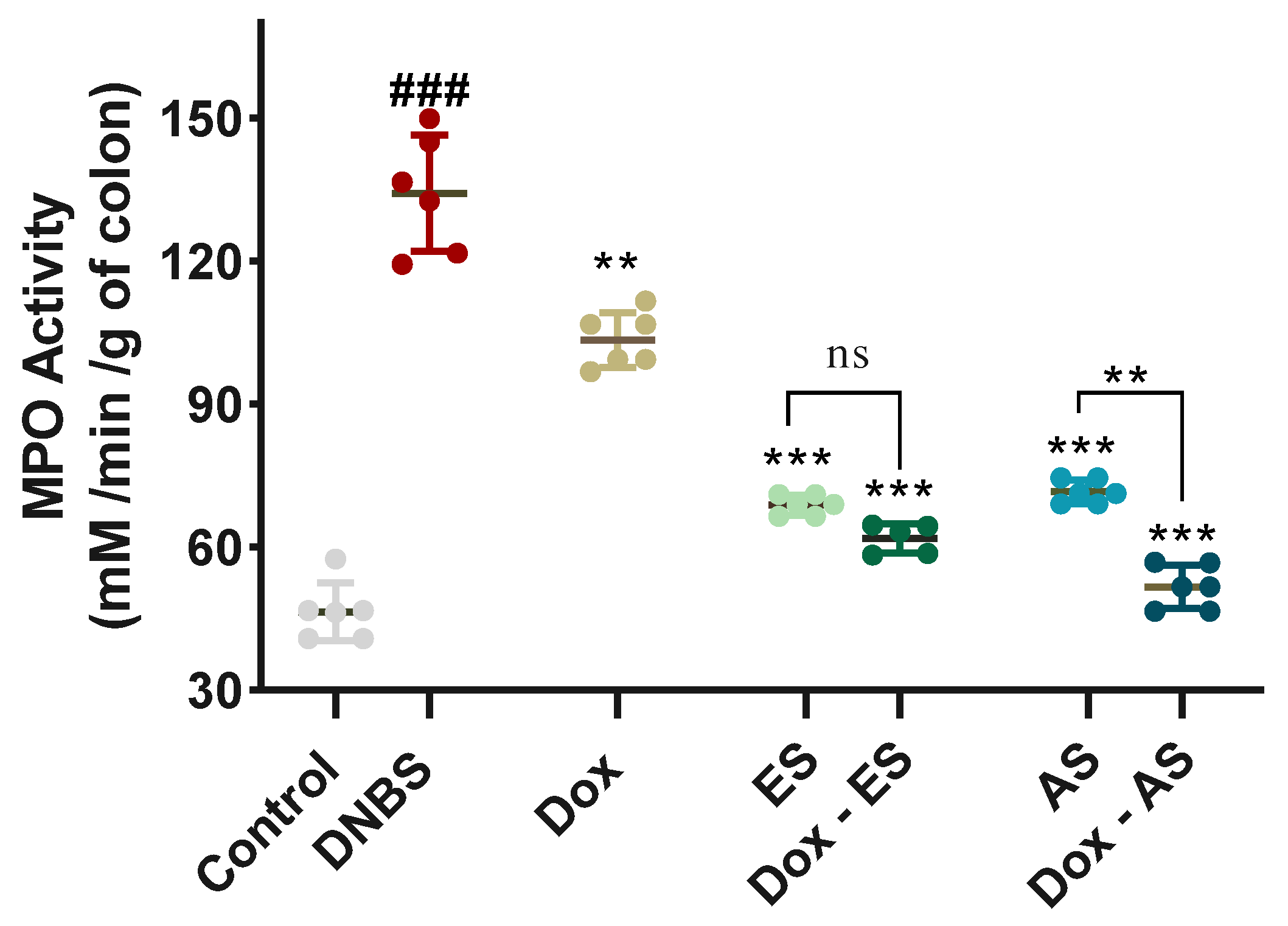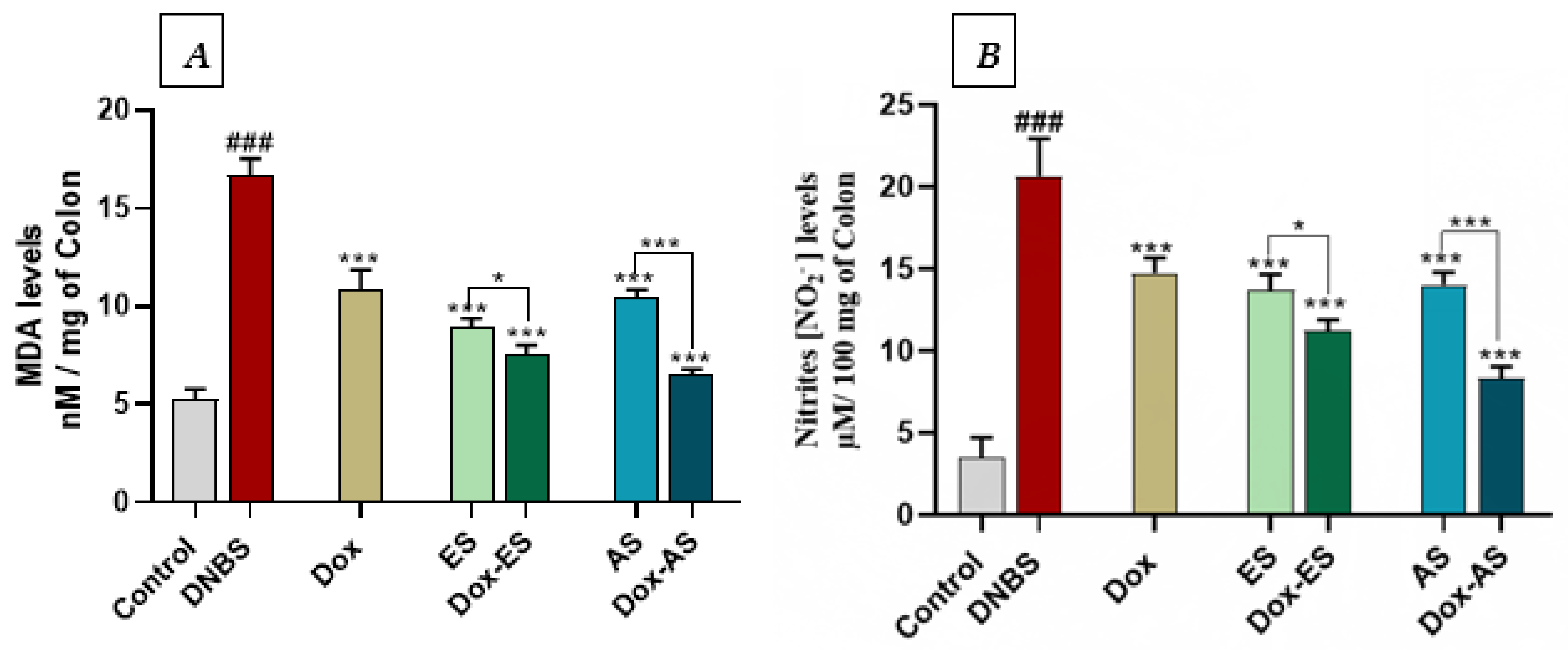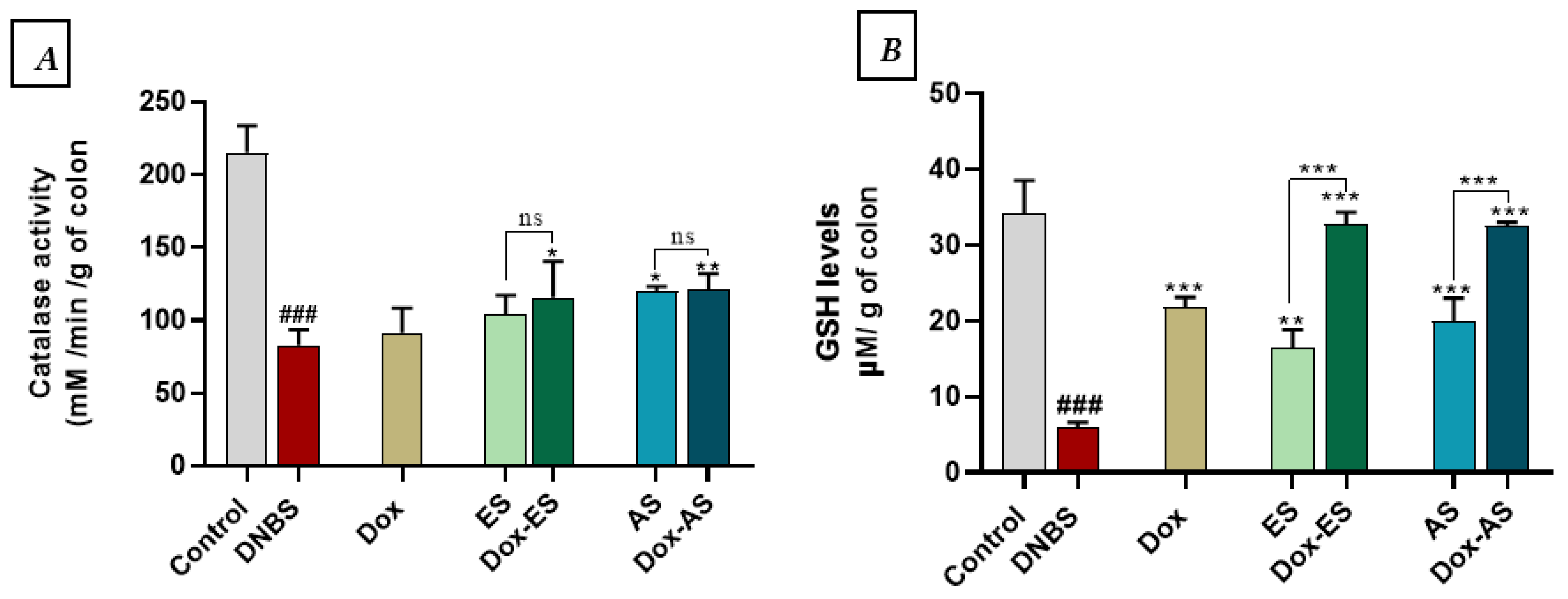A Synergistic Approach with Doxycycline and Spirulina Extracts in DNBS-Induced Colitis: Enhancing Remission and Controlling Relapse
Abstract
1. Introduction
2. Materials and Methods
2.1. Biological Material and Reagents
2.2. Preparation of A. platensis Extracts
2.3. Derivatized GC-MS Profiling
2.4. Animals and Experimental Design
2.5. Clinical and Macroscopic Evaluation of Colitis
2.6. Histopathological Assessment
2.7. Assessment of Inflammatory and Redox Markers
2.7.1. Myeloperoxidase (MPO) Activity
2.7.2. Nitrite Quantification
2.7.3. Measurement of Lipid Peroxidation
2.7.4. Catalase (CAT) Activity
2.7.5. Reduced Glutathione (GSH) Content
2.8. Statistical Analysis
3. Results
3.1. GC-MS Analysis of Derivatized A. platensis Extracts
3.2. Clinical Assessment of Colitis Severity
3.3. Macroscopic Assessment of Colonic Damage
3.4. Histological Assessment of Colonic Tissue
3.5. MPO Activity as a Marker of Neutrophil Infiltration
3.6. Lipid Peroxidation and Nitrosative Stress Markers
3.7. Antioxidant Defense Markers
4. Discussion
5. Conclusions
Supplementary Materials
Author Contributions
Funding
Institutional Review Board Statement
Data Availability Statement
Acknowledgments
Conflicts of Interest
Abbreviations
| CD | Crohn’s Disease |
| COX-2 | Cyclooxygenase-2 |
| DAI | Disease Activity Index |
| DNBS | Dinitrobenzene Sulfonic Acid |
| GSH | Reduced Glutathion |
| HTAB | Hexadecyl-Trimethyl-Ammonium Bromide |
| IBD | Inflammatory Bowel Disease |
| ICAM-3 | Intercellular Adhesion Molecule-1 |
| IL-6 | Interleukin 6. |
| iNOS | Inducible Nitric Oxide Synthase |
| MDA | Malondialdehyde. |
| MPO | Myeloperoxydase. |
| MUC-1 | Mucin-1 |
| MUC-3 | Mucin-3 |
| NF-κB | Nuclear factor kappa B |
| NO | Nitric Oxide. |
| PGE2 | Prostaglandin E2. |
| PMS | Post-Mitochondrial Supernatant. |
| RNS | Reactive Nitrogen Species. |
| ROS | Reactive Oxygen Species. |
| TNF-α | Tumor Necrosis Factor-Alpha. |
| UC | Ulcerative Colitis. |
References
- Calvez, V.; Puca, P.; Di Vincenzo, F.; Del Gaudio, A.; Bartocci, B.; Murgiano, M.; Iaccarino, J.; Parand, E.; Napolitano, D.; Pugliese, D.; et al. Novel Insights into the Pathogenesis of Inflammatory Bowel Diseases. Biomedicines 2025, 13, 305. [Google Scholar] [CrossRef] [PubMed]
- Kong, L.; Chen, S.; Huang, S.; Zheng, A.; Gao, S.; Ye, J.; Hua, C. Challenges and Opportunities in Inflammatory Bowel Disease: From Current Therapeutic Strategies to Organoid-Based Models. Inflamm. Res. 2024, 73, 541–562. [Google Scholar] [CrossRef]
- Bribi, N.; Yanat, B.; Ouahmed-Boudaoud, H. Immunopathogenesis of Ulcerative Colitis and Crohn’s Disease. Int. J. Adv. Res. Microbiol. Immunol. 2019, 1, 45–48. [Google Scholar]
- Alemany-Cosme, E.; Sáez-González, E.; Moret, I.; Mateos, B.; Iborra, M.; Nos, P.; Sandoval, J.; Beltrán, B. Oxidative Stress in the Pathogenesis of Crohn’s Disease and the Interconnection with Immunological Response, Microbiota, External Environmental Factors, and Epigenetics. Antioxidants 2021, 10, 64. [Google Scholar] [CrossRef]
- Megha, K.B.; Joseph, X.; Akhil, V.; Mohanan, P.V. Cascade of Immune Mechanism and Consequences of Inflammatory Disorders. Phytomedicine 2021, 91, 153712. [Google Scholar] [CrossRef]
- Park, J.; Cheon, J.H. Updates on Conventional Therapies for Inflammatory Bowel Diseases: 5-Aminosalicylates, Corticosteroids, Immunomodulators, and Anti-TNF-α. Korean J. Intern. Med. 2022, 37, 895–905. [Google Scholar] [CrossRef]
- Sebastian, S.A.; Kaiwan, O.; Co, E.L.; Mehendale, M.; Mohan, B.P. Current Pharmacologic Options and Emerging Therapeutic Approaches for the Management of Ulcerative Colitis: A Narrative Review. Spartan Med. Res. J. 2024, 9, 123397. [Google Scholar] [CrossRef]
- Subramanian, R.; Triadafilopoulos, G. Care of Inflammatory Bowel Disease Patients in Remission. Gastroenterol. Rep. 2016, 4, 261–271. [Google Scholar] [CrossRef]
- Cai, Z.; Wang, S.; Li, J. Treatment of Inflammatory Bowel Disease: A Comprehensive Review. Front. Med. 2021, 8, 765474. [Google Scholar] [CrossRef]
- Bourgonje, A.R.; Feelisch, M.; Faber, K.N.; Pasch, A.; Dijkstra, G.; van Goor, H. Oxidative Stress and Redox-Modulating Therapeutics in Inflammatory Bowel Disease. Trends Mol. Med. 2020, 26, 1034–1046. [Google Scholar] [CrossRef] [PubMed]
- Tian, T.; Wang, Z.; Zhang, J. Pathomechanisms of Oxidative Stress in Inflammatory Bowel Disease and Potential Antioxidant Therapies. Oxidative Med. Cell. Longev. 2017, 2017, 4535194. [Google Scholar] [CrossRef]
- He, B.; Lu, C.; Zheng, G.; He, X.; Wang, M.; Chen, G.; Zhang, G.; Lu, A. Combination Therapeutics in Complex Diseases. J. Cell. Mol. Med. 2016, 20, 2231–2240. [Google Scholar] [CrossRef] [PubMed]
- Malik, M.A.; Wani, M.Y.; Hashmi, A.A. Chapter 1—Combination Therapy: Current Status and Future Perspectives. In Combination Therapy Against Multidrug Resistance; Wani, M.Y., Ahmad, A., Eds.; Academic Press: Cambridge, MA, USA, 2020; pp. 1–38. ISBN 978-0-12-820576-1. [Google Scholar]
- Sagar, J. Doxycycline in Clinical Medicine. Clin. Med. Insights Ther. 2010, 2, CMT.S2985. [Google Scholar] [CrossRef]
- Majewski, M. A Current Opinion on the Safety and Efficacy of Doxycycline Including Parenteral Administration—A Review. Pol. Ann. Med. 2014, 21, 57–62. [Google Scholar] [CrossRef]
- Navarro-Triviño, F.J.; Pérez-López, I.; Ruiz-Villaverde, R. Doxycycline, an Antibiotic or an Anti-Inflammatory Agent? The Most Common Uses in Dermatology. Actas Dermosifiliogr. 2020, 111, 561–566. [Google Scholar] [CrossRef]
- Clemens, D.L.; Duryee, M.J.; Sarmiento, C.; Chiou, A.; McGowan, J.D.; Hunter, C.D.; Schlichte, S.L.; Tian, J.; Klassen, L.W.; O’Dell, J.R.; et al. Novel Antioxidant Properties of Doxycycline. Int. J. Mol. Sci. 2018, 19, 4078. [Google Scholar] [CrossRef]
- Di Caprio, R.; Lembo, S.; Di Costanzo, L.; Balato, A.; Monfrecola, G. Anti-Inflammatory Properties of Low and High Doxycycline Doses: An In Vitro Study. Mediators Inflamm. 2015, 2015, 329418. [Google Scholar] [CrossRef]
- Nakagawa, T.; Kakizoe, Y.; Iwata, Y.; Miyasato, Y.; Mizumoto, T.; Adachi, M.; Izumi, Y.; Kuwabara, T.; Suenaga, N.; Narita, Y.; et al. Doxycycline Attenuates Cisplatin-Induced Acute Kidney Injury through Pleiotropic Effects. Am. J. Physiol. Ren. Physiol. 2018, 315, F1347–F1357. [Google Scholar] [CrossRef] [PubMed]
- Ledder, O. Antibiotics in Inflammatory Bowel Diseases: Do We Know What We’re Doing? Transl. Pediatr. 2019, 8, 42–55. [Google Scholar] [CrossRef]
- Garrido-Mesa, J.; Algieri, F.; Rodriguez-Nogales, A.; Utrilla, M.P.; Rodriguez-Cabezas, M.E.; Zarzuelo, A.; Ocete, M.A.; Garrido-Mesa, N.; Galvez, J. A New Therapeutic Association to Manage Relapsing Experimental Colitis: Doxycycline plus Saccharomyces boulardii. Pharmacol. Res. 2015, 97, 48–63. [Google Scholar] [CrossRef] [PubMed]
- Garrido-Mesa, J.; Rodríguez-Nogales, A.; Algieri, F.; Vezza, T.; Hidalgo-Garcia, L.; Garrido-Barros, M.; Utrilla, M.P.; Garcia, F.; Chueca, N.; Rodriguez-Cabezas, M.E.; et al. Immunomodulatory Tetracyclines Shape the Intestinal Inflammatory Response Inducing Mucosal Healing and Resolution. Br. J. Pharmacol. 2018, 175, 4353–4370. [Google Scholar] [CrossRef] [PubMed]
- Chan, P.A.; Le Brazidec, D.L.; Becasen, J.S.; Martin, H.; Kapadia, J.; Reno, H.; Bachmann, L.; Barbee, L.A. Safety of Longer-Term Doxycycline Use: A Systematic Review and Meta-Analysis with Implications for Bacterial STI Chemoprophylaxis. Sex. Transm. Dis. 2023, 50, 701–712. [Google Scholar] [CrossRef] [PubMed]
- Carpenter, L.; Miller, S.; Flynn, E.; Choo, J.M.; Collins, J.; Shoubridge, A.P.; Gordon, D.; Lynn, D.J.; Whitehead, C.; Leong, L.E.X.; et al. Exposure to Doxycycline Increases Risk of Carrying a Broad Range of Enteric Antimicrobial Resistance Determinants in an Elderly Cohort. J. Infect. 2024, 89, 106243. [Google Scholar] [CrossRef] [PubMed]
- Aware, C.B.; Patil, D.N.; Suryawanshi, S.S.; Mali, P.R.; Rane, M.R.; Gurav, R.G.; Jadhav, J.P. Natural Bioactive Products as Promising Therapeutics: A Review of Natural Product-Based Drug Development. S. Afr. J. Bot. 2022, 151, 512–528. [Google Scholar] [CrossRef]
- Saharan, V.; Jood, S. NUTRITIONAL COMPOSITION OF SPIRULINA PLATENSIS POWDER AND ITS ACCEPTABILITY IN FOOD PRODUCTS. Int. J. Adv. Res. 2017, 5, 2295–2300. [Google Scholar] [CrossRef]
- Seghiri, R.; Kharbach, M.; Essamri, A. Functional Composition, Nutritional Properties, and Biological Activities of Moroccan Spirulina Microalga. J. Food Qual. 2019, 2019, e3707219. [Google Scholar] [CrossRef]
- Morsy, M.A.; Gupta, S.; Nair, A.B.; Venugopala, K.N.; Greish, K.; El-Daly, M. Protective Effect of Spirulina Platensis Extract against Dextran-Sulfate-Sodium-Induced Ulcerative Colitis in Rats. Nutrients 2019, 11, 2309. [Google Scholar] [CrossRef]
- Agustina, S.; Aidha, N.N.; Oktarina, E.; Kurniati, N.F. Evaluation of Antioxidant and Wound Healing Activities of Spirulina sp. Extract. Egypt. J. Chem. 2021, 64, 4601–4610. [Google Scholar] [CrossRef]
- Abd El-Fattah Elshouny, W.; Mohammed El-Sheekh, M.; Zaki Sabae, S.; Abdelfattah Khalil, M.; Mohamed Badr, H. ANTIMICROBIAL ACTIVITY of SPIRULINA PLATENSIS AGAINST AQUATIC BACTERIAL ISOLATES. J. Microbiol. Biotechnol. Food Sci. 2017, 6, 1203–1208. [Google Scholar] [CrossRef]
- Aziez, M.; Bribi, N.; Sofiane, M.M.; Riad, F.; Affenai, S. Intestinal Anti-Inflammatory and Antioxidant Potential of Arthrospira Platensis Aqueous Extract on DNBS-Induced Colitis in BALB/c Mice. Curr. Chem. Biol. 2024, 18, 238–248. [Google Scholar] [CrossRef]
- Aziez, M.; Suharoschi, R.; Merakeb, M.S.; Pop, O.L.; Ciont, C.; Ranga, F.; Ferhat, R.; Affenai, S.; Vodnar, D.C.; Cozma, A.; et al. Phenolic Profiling and Bioactive Properties of Arthrospira Platensis Extract in Alleviating Acute and Sub-Chronic Colitis. Int. J. Mol. Sci. 2025, 26, 5692. [Google Scholar] [CrossRef]
- Hutadilok-Towatana, N.; Reanmongkol, W.; Panichayupakaranant, P. Evaluation of the Toxicity of Arthrospira (Spirulina) Platensis Extract. J. Appl. Phycol. 2010, 22, 599–605. [Google Scholar] [CrossRef]
- Khafaga, A.F.; El-Sayed, Y.S. Spirulina Ameliorates Methotrexate Hepatotoxicity via Antioxidant, Immune Stimulation, and Proinflammatory Cytokines and Apoptotic Proteins Modulation. Life Sci. 2018, 196, 9–17. [Google Scholar] [CrossRef] [PubMed]
- Garrido-Mesa, N.; Camuesco, D.; Arribas, B.; Comalada, M.; Bailón, E.; Cueto-Sola, M.; Utrilla, P.; Nieto, A.; Zarzuelo, A.; Rodríguez-Cabezas, M.E.; et al. The Intestinal Anti-Inflammatory Effect of Minocycline in Experimental Colitis Involves Both Its Immunomodulatory and Antimicrobial Properties. Pharmacol. Res. 2011, 63, 308–319. [Google Scholar] [CrossRef] [PubMed]
- Khajah, M.A.; Hawai, S.; Barakat, A.; Albaloushi, A.; Alkharji, M.; Masocha, W. Minocycline Synergizes with Corticosteroids in Reducing Colitis Severity in Mice via the Modulation of Pro-Inflammatory Molecules. Front. Pharmacol. 2023, 14, 1252174. [Google Scholar] [CrossRef]
- Garcia, F.A.d.O.; Sales-Campos, H.; Yuen, V.G.; Machado, J.R.; Viana, G.S.d.B.; McNeill, J.H. Arthrospira (Spirulina) Platensis Attenuates Dextran Sulfate Sodium-Induced Colitis in Mice by Suppressing Key Pro-Inflammatory Cytokines. Korean J. Gastroenterol. 2020, 76, 150–158. [Google Scholar] [CrossRef]
- Hove, T.T.; Corbaz, A.; Amitai, H.; Aloni, S.; Belzer, I.; Graber, P.; Drillenburg, P.; Van Deventer, S.J.H.; Chvatchko, Y.; Te Velde, A.A. Blockade of Endogenous IL-18 Ameliorates TNBS-Induced Colitis by Decreasing Local TNF-α Production in Mice. Gastroenterology 2001, 121, 1372–1379. [Google Scholar] [CrossRef] [PubMed]
- Merakeb, M.S.; Bribi, N.; Ferhat, R.; Aziez, M.; Yanat, B. Alkaloids Extract from Linum Usitatissimum Attenuates 12-OTetradecanoylphorbol- 13-Acetate (TPA)-Induced Inflammation and Oxidative Stress in Mouse Skin. Anti-Inflamm. Anti-Allergy Agents Med. Chem. 2023, 21, 179–187. [Google Scholar] [CrossRef]
- Rehman, I.U.; Saleem, M.; Raza, S.A.; Bashir, S.; Muhammad, T.; Asghar, S.; Qamar, M.U.; Shah, T.A.; Bin Jardan, Y.A.; Mekonnen, A.B.; et al. Anti-Ulcerative Colitis Effects of Chemically Characterized Extracts from Calliandra Haematocephala in Acetic Acid-Induced Ulcerative Colitis. Front. Chem. 2024, 12, 1291230. [Google Scholar] [CrossRef]
- Avula, S.K.; Khan, A.; Halim, S.A.; Rehman, N.U.; Karim, N.; Khan, I.; Csuk, R.; Das, B.; Al-Harrasi, A. Synthesis and Antidepressant-like Effects of New 5-Epi-Incensole and 5-Epi—Incensole Acetate in Chronic Unpredictable Mild Stress Model of Depression; Behavioural and Biochemical Correlates. Biomed. Pharmacother. 2022, 156, 113960. [Google Scholar] [CrossRef]
- Rathore, P.; Arora, I.; Rastogi, S.; Akhtar, M.; Singh, S.; Samim, M. Collagen Nanoparticle-Mediated Brain Silymarin Delivery: An Approach for Treating Cerebral Ischemia and Reperfusion-Induced Brain Injury. Front. Neurosci. 2020, 14, 538404. [Google Scholar] [CrossRef]
- Zhao, S.; Li, L. Chemical Derivatization for Polar Metabolome Analysis. In MALDI Mass Spectrometry Imaging; Royal Society of Chemistry: London, UK, 2021. [Google Scholar] [CrossRef]
- Huang, T.; Toro, M.; Lee, R.; Hui, D.S.; Edwards, J.L. Multi-Functional Derivatization of Amine, Hydroxyl, and Carboxylate Groups for Metabolomic Investigations of Human Tissue by Electrospray Ionization Mass Spectrometry. Analyst 2018, 143, 3408–3414. [Google Scholar] [CrossRef] [PubMed]
- Zhou, Y.-Q.; Wang, Z.-J.; Jia, N. Formation of Multiple Trimethylsilyl Derivatives in the Derivatization of 17alpha-Ethinylestradiol with BSTFA or MSTFA Followed by Gas Chromatography-Mass Spectrometry Determination. J. Environ. Sci. China 2007, 19, 879–884. [Google Scholar] [CrossRef]
- Parvatam, R.; Singh, R.; Sharma, R. Comparison of Different Derivatising Reagents in Identification of Milk Metabolites Using GC–MS. Int. Dairy J. 2023, 138, 105535. [Google Scholar] [CrossRef]
- Liao, H.-Y.; Wang, C.-Y.; Lee, C.-H.; Kao, H.-L.; Wu, W.-K.; Kuo, C.-H. Development of an Efficient and Sensitive Chemical Derivatization-Based LC-MS/MS Method for Quantifying Gut Microbiota-Derived Metabolites in Human Plasma and Its Application in Studying Cardiovascular Disease. J. Proteome Res. 2021, 20, 3508–3518. [Google Scholar] [CrossRef] [PubMed]
- Xue, G.; Su, S.; Yan, P.; Shang, J.; Wang, J.; Yan, C.; Li, J.; Wang, Q.; Xiong, X.; Xu, H. Integrative Analyses of Widely Targeted Metabolomic Profiling and Derivatization-Based LC-MS/MS Reveals Metabolic Changes of Zingiberis Rhizoma and Its Processed Products. Food Chem. 2022, 389, 133068. [Google Scholar] [CrossRef]
- Plaskova, A.; Mlcek, J. New Insights of the Application of Water or Ethanol-Water Plant Extract Rich in Active Compounds in Food. Front. Nutr. 2023, 10, 1118761. [Google Scholar] [CrossRef]
- Monroy, Y.M.; Rodrigues, R.A.F.; Sartoratto, A.; Cabral, F.A. Influence of Ethanol, Water, and Their Mixtures as Co-Solvents of the Supercritical Carbon Dioxide in the Extraction of Phenolics from Purple Corn Cob (Zea mays L.). J. Supercrit. Fluids 2016, 118, 11–18. [Google Scholar] [CrossRef]
- Jha, A.K.; Sit, N. Extraction of Bioactive Compounds from Plant Materials Using Combination of Various Novel Methods: A Review. Trends Food Sci. Technol. 2022, 119, 579–591. [Google Scholar] [CrossRef]
- Tuhanioglu, A.; Kaur, S.; De Barros, G.L.; Ahmadzadeh, S.; Threlfall, R.; Ubeyitogullari, A. Optimizing Ethanol-Water Cosolvent Systems for Green Supercritical Carbon Dioxide Extraction of Muscadine Grape Pomace Polyphenols. ACS Omega 2025, 10, 4860–4869. [Google Scholar] [CrossRef]
- Lezoul, N.E.H.; Belkadi, M.; Habibi, F.; Guillén, F. Extraction Processes with Several Solvents on Total Bioactive Compounds in Different Organs of Three Medicinal Plants. Molecules 2020, 25, 4672. [Google Scholar] [CrossRef]
- Mühling, M.; Belay, A.; Whitton, B.A. Variation in Fatty Acid Composition of Arthrospira (Spirulina) Strains. J. Appl. Phycol. 2005, 17, 137–146. [Google Scholar] [CrossRef]
- Taiti, C.; Di Vito, M.; Di Mercurio, M.; Costantini, L.; Merendino, N.; Sanguinetti, M.; Bugli, F.; Garzoli, S. Detection of Secondary Metabolites, Proximate Composition and Bioactivity of Organic Dried Spirulina (Arthrospira platensis). Appl. Sci. 2024, 14, 67. [Google Scholar] [CrossRef]
- Ji, J.; Xu, Y.; Zheng, M.; Luo, C.; Lei, H.; Qu, H.; Shu, D. Methionine Attenuates Lipopolysaccharide-Induced Inflammatory Responses via DNA Methylation in Macrophages. ACS Omega 2019, 4, 2331–2336. [Google Scholar] [CrossRef]
- Lauinger, L.; Kaiser, P. Sensing and Signaling of Methionine Metabolism. Metabolites 2021, 11, 83. [Google Scholar] [CrossRef]
- Levine, R.L.; Moskovitz, J.; Stadtman, E.R. Oxidation of Methionine in Proteins: Roles in Antioxidant Defense and Cellular Regulation. IUBMB Life 2000, 50, 301–307. [Google Scholar] [CrossRef]
- Hosseini, A.; Mas, J. The β-Galactosidase Assay in Perspective: Critical Thoughts for Biosensor Development. Anal. Biochem. 2021, 635, 114446. [Google Scholar] [CrossRef]
- Sharma, S.K.; Sharma, S.P.; Leblanc, R.M. Methods of Detection of β-Galactosidase Enzyme in Living Cells. Enzyme Microb. Technol. 2021, 150, 109885. [Google Scholar] [CrossRef] [PubMed]
- Kremer, B.P.; Kirst, G.O. Biosynthesis of 2-O-D-Glycerol-α-D-Galactopyranoside (Floridoside) in Marine Rhodophyceae. Plant Sci. Lett. 1981, 23, 349–357. [Google Scholar] [CrossRef]
- Liu, D.; Wang, Y.; Lu, Z.; Lv, F.; Bie, X.; Zhao, H. Separation, Characterization and Anti-Inflammatory Activities of Galactoglycerolipids from Perilla frutescens (L.) Britton. Nat. Prod. Res. 2023, 37, 3610–3615. [Google Scholar] [CrossRef]
- Jiang, Y.; Wei, Y.; Zhou, Q.-Y.; Sun, G.-Q.; Fu, X.-P.; Levin, N.; Zhang, Y.; Liu, W.-Q.; Song, N.; Mohammed, S.; et al. Direct Radical Functionalization of Native Sugars. Nature 2024, 631, 319–327. [Google Scholar] [CrossRef]
- Li, S.; Lv, M.; Zhang, S.; Xu, H. Advances on Monosaccharides and Oligosaccharides: Structural Modifications and Bioactivities. Mini Rev. Med. Chem. 2021, 21, 2551–2566. [Google Scholar] [CrossRef]
- Arnone, D.; Chabot, C.; Heba, A.-C.; Kökten, T.; Caron, B.; Hansmannel, F.; Dreumont, N.; Ananthakrishnan, A.N.; Quilliot, D.; Peyrin-Biroulet, L. Sugars and Gastrointestinal Health. Clin. Gastroenterol. Hepatol. 2022, 20, 1912–1924.e7. [Google Scholar] [CrossRef]
- Araújo, R.P.N.; da Silva Freitas, F.V.; Nunes, D.B.; da Silva Brito, A.K.; da Costa, D.S.; de Sousa, D.P.; de Cássia Meneses Oliveira, R.; dos Santos, R.F. Investigating the Pharmacological Potential of Phytol on Experimental Models of Gastric Ulcer in Rats. Naunyn. Schmiedebergs Arch. Pharmacol. 2024, 397, 7757–7766. [Google Scholar] [CrossRef]
- Olofsson, P.; Hultqvist, M.; Hellgren, L.I.; Holmdahl, R. Phytol: A Chlorophyll Component with Anti-Inflammatory and Metabolic Properties. In Recent Advances in Redox Active Plant and Microbial Products: From Basic Chemistry to Widespread Applications in Medicine and Agriculture; Jacob, C., Kirsch, G., Slusarenko, A., Winyard, P.G., Burkholz, T., Eds.; Springer: Dordrecht, The Netherlands, 2014; pp. 345–359. ISBN 978-94-017-8953-0. [Google Scholar]
- Pejin, B.; Savic, A.; Sokovic, M.; Glamoclija, J.; Ciric, A.; Nikolic, M.; Radotic, K.; Mojovic, M. Further in Vitro Evaluation of Antiradical and Antimicrobial Activities of Phytol. Nat. Prod. Res. 2014, 28, 372–376. [Google Scholar] [CrossRef]
- Silva, R.O.; Sousa, F.B.M.; Damasceno, S.R.B.; Carvalho, N.S.; Silva, V.G.; Oliveira, F.R.M.A.; Sousa, D.P.; Aragão, K.S.; Barbosa, A.L.R.; Freitas, R.M.; et al. Phytol, a Diterpene Alcohol, Inhibits the Inflammatory Response by Reducing Cytokine Production and Oxidative Stress. Fundam. Clin. Pharmacol. 2014, 28, 455–464. [Google Scholar] [CrossRef] [PubMed]
- Sadukha, S.; Bhayani, A.; Padariya, H.; Vaghela, P.; Mishra, S.; Ghosh, A.; Dineshkumar, R. Performance Evaluation of Microalgal Strains for Concurrent Production of High-Value Bio-Actives Lutein and Phytol: A Step Forward towards the Multi-Product Paradigm. Biocatal. Agric. Biotechnol. 2023, 50, 102737. [Google Scholar] [CrossRef]
- Garavaglia, B.; Vallino, L.; Amoruso, A.; Pane, M.; Ferraresi, A.; Isidoro, C. The Role of Gut Microbiota, Immune System, and Autophagy in the Pathogenesis of Inflammatory Bowel Disease: Molecular Mechanisms and Therapeutic Approaches. Asp. Mol. Med. 2024, 4, 100056. [Google Scholar] [CrossRef]
- Ko, J.K.; Auyeung, K.K. Inflammatory Bowel Disease: Etiology, Pathogenesis and Current Therapy. Curr. Pharm. Des. 2014, 20, 1082–1096. [Google Scholar] [CrossRef] [PubMed]
- Eljaaly, K.; Alghamdi, H.; Almehmadi, H.; Aljawi, F.; Hassan, A.; Thabit, A. Long-Term Gastrointestinal Adverse Effects of Doxycycline. J. Infect. Dev. Ctries. 2023, 17, 281–285. [Google Scholar] [CrossRef]
- Wang, J.; Gan, Q.; Zhang, H.; Xing, Q.; Wu, Y.; Su, X.; Zhang, N.; Wu, K. Long-Term Doxycycline Therapy for Stable Chronic Obstructive Pulmonary Disease: Do the Benefits Outweigh the Drawbacks? Am. J. Respir. Crit. Care Med. 2023, 208, 1143–1144. [Google Scholar] [CrossRef] [PubMed]
- Duan, L.; Cheng, S.; Li, L.; Liu, Y.; Wang, D.; Liu, G. Natural Anti-Inflammatory Compounds as Drug Candidates for Inflammatory Bowel Disease. Front. Pharmacol. 2021, 12, 684486. [Google Scholar] [CrossRef] [PubMed]
- Park, Y.H.; Kim, N.; Shim, Y.K.; Choi, Y.J.; Nam, R.H.; Choi, Y.J.; Ham, M.H.; Suh, J.H.; Lee, S.M.; Lee, C.M.; et al. Adequate Dextran Sodium Sulfate-Induced Colitis Model in Mice and Effective Outcome Measurement Method. J. Cancer Prev. 2015, 20, 260–267. [Google Scholar] [CrossRef] [PubMed]
- Morampudi, V.; Bhinder, G.; Wu, X.; Dai, C.; Sham, H.P.; Vallance, B.A.; Jacobson, K. DNBS/TNBS Colitis Models: Providing Insights into Inflammatory Bowel Disease and Effects of Dietary Fat. J. Vis. Exp. JoVE 2014, 84, 51297. [Google Scholar] [CrossRef]
- Ahn, S.-I.; Cho, S.; Choi, N.-J. Effect of Dietary Probiotics on Colon Length in an Inflammatory Bowel Disease-Induced Murine Model: A Meta-Analysis. J. Dairy Sci. 2020, 103, 1807–1819. [Google Scholar] [CrossRef] [PubMed]
- Abdel-Daim, M.M.; Farouk, S.M.; Madkour, F.F.; Azab, S.S. Anti-Inflammatory and Immunomodulatory Effects of Spirulina Platensis in Comparison to Dunaliella salina in Acetic Acid-Induced Rat Experimental Colitis. Immunopharmacol. Immunotoxicol. 2015, 37, 126–139. [Google Scholar] [CrossRef]
- Wu, Q.; Liu, L.; Miron, A.; Klímová, B.; Wan, D.; Kuča, K. The Antioxidant, Immunomodulatory, and Anti-Inflammatory Activities of Spirulina: An Overview. Arch. Toxicol. 2016, 90, 1817–1840. [Google Scholar] [CrossRef]
- Hanning, N.; De Man, J.G.; De Winter, B.Y. Measuring Myeloperoxidase Activity as a Marker of Inflammation in Gut Tissue Samples of Mice and Rat. Bio-Protocol. 2023, 13, e4758. [Google Scholar] [CrossRef]
- Mancini, S.; Mariani, F.; Sena, P.; Benincasa, M.; Roncucci, L. Myeloperoxidase Expression in Human Colonic Mucosa Is Related to Systemic Oxidative Balance in Healthy Subjects. Redox Rep. Commun. Free Radic. Res. 2017, 22, 399–407. [Google Scholar] [CrossRef]
- da Silva, V.C.; de Araújo, A.A.; Araújo, D.F.d.S.; Lima, M.C.J.S.; Vasconcelos, R.C.; de Araújo Júnior, R.F.; Langasnner, S.M.Z.; Pedrosa, M. de F.F.; de Medeiros, C.A.C.X.; Guerra, G.C.B. Intestinal Anti-Inflammatory Activity of the Aqueous Extract from Ipomoea Asarifolia in DNBS-Induced Colitis in Rats. Int. J. Mol. Sci. 2018, 19, 4016. [Google Scholar] [CrossRef]
- Bribi, N.; Algieri, F.; Nogales, A.; Vezza, T.; Garrido-Mesa, J.; Utrilla, M.; Contreras, M.d.M.; Maiza, F.; Segura Carretero, A.; Rodriguez-Cabezas, M.; et al. Intestinal Anti-Inflammatory Effects of Total Alkaloid Extract from Fumaria Capreolata in the DNBS Model of Mice Colitis and Intestinal Epithelial CMT93 Cells. Phytomedicine 2016, 23, 901–913. [Google Scholar] [CrossRef] [PubMed]
- Eissa, N.; Kermarrec, L.; Hussein, H.; Bernstein, C.N.; Ghia, J.-E. Appropriateness of Reference Genes for Normalizing Messenger RNA in Mouse 2,4-Dinitrobenzene Sulfonic Acid (DNBS)-Induced Colitis Using Quantitative Real Time PCR. Sci. Rep. 2017, 7, 42427. [Google Scholar] [CrossRef]
- Wang, X.; Zhang, C.; Bao, N. Molecular Mechanism of Palmitic Acid and Its Derivatives in Tumor Progression. Front. Oncol. 2023, 13, 1224125. [Google Scholar] [CrossRef] [PubMed]
- Mizunoe, Y.; Kobayashi, M.; Sudo, Y.; Watanabe, S.; Yasukawa, H.; Natori, D.; Hoshino, A.; Negishi, A.; Okita, N.; Komatsu, M.; et al. Trehalose Protects against Oxidative Stress by Regulating the Keap1-Nrf2 and Autophagy Pathways. Redox Biol. 2018, 15, 115–124. [Google Scholar] [CrossRef]
- Yang, L.; Zhao, X.; Zhu, H.; Paul, M.; Zu, Y.; Tang, Z. Exogenous Trehalose Largely Alleviates Ionic Unbalance, ROS Burst, and PCD Occurrence Induced by High Salinity in Arabidopsis Seedlings. Front. Plant Sci. 2014, 5, 570. [Google Scholar] [CrossRef] [PubMed]
- Kiruthiga, C.; Balan, D.J.; Jafni, S.; Anandan, D.P.; Devi, K.P. Phytol and (−)-α-Bisabolol Synergistically Trigger Intrinsic Apoptosis through Redox and Ca2+ Imbalance in Non-Small Cell Lung Cancer. Biocatal. Agric. Biotechnol. 2024, 56, 103005. [Google Scholar] [CrossRef]
- Babusyte, A.; Kotthoff, M.; Fiedler, J.; Krautwurst, D. Biogenic Amines Activate Blood Leukocytes via Trace Amine-Associated Receptors TAAR1 and TAAR2. J. Leukoc. Biol. 2013, 93, 387–394. [Google Scholar] [CrossRef]
- Patel, A.; Thompson, A.; Abdelmalek, L.; Adams-Huet, B.; Jialal, I. The Relationship between Tyramine Levels and Inflammation in Metabolic Syndrome. Horm. Mol. Biol. Clin. Investig. 2019, 40, 20190047. [Google Scholar] [CrossRef]
- Yongkhamcha, B.; Buddhakala, N. Phytochemical Compositions, Nutritional Contents, Cytotoxicity and Anti-Inflammatory Activity of Different Extracts from Spirogyra Neglecta (Hassall) Kützing. Trends Sci. 2023, 20, 6528. [Google Scholar] [CrossRef]
- Aba, P.E.; Odugbo, I.O. Metabolite Profiling and in Silico Studies to Elucidate the Anti-Inflammatory Properties of Pterocarpus Milbreadii. Curr. Enzyme Inhib. 2024, 20, 71–77. [Google Scholar] [CrossRef]
- Coskun, Z.K.; Kerem, M.; Gurbuz, N.; Omeroglu, S.; Pasaoglu, H.; Demirtas, C.; Lortlar, N.; Salman, B.; Pasaoglu, O.T.; Turgut, H.B. The Study of Biochemical and Histopathological Effects of Spirulina in Rats with TNBS-Induced Colitis. Bratisl. Lek. Listy 2011, 112, 235–243. [Google Scholar] [PubMed]







Disclaimer/Publisher’s Note: The statements, opinions and data contained in all publications are solely those of the individual author(s) and contributor(s) and not of MDPI and/or the editor(s). MDPI and/or the editor(s) disclaim responsibility for any injury to people or property resulting from any ideas, methods, instructions or products referred to in the content. |
© 2025 by the authors. Licensee MDPI, Basel, Switzerland. This article is an open access article distributed under the terms and conditions of the Creative Commons Attribution (CC BY) license (https://creativecommons.org/licenses/by/4.0/).
Share and Cite
Aziez, M.; Mahdjoub, M.M.; Benayad, T.; Abbas, F.; Hamid, S.; Moussa, H.; Sall, I.M.; Tahraoui, H.; Amrane, A.; Bribi, N. A Synergistic Approach with Doxycycline and Spirulina Extracts in DNBS-Induced Colitis: Enhancing Remission and Controlling Relapse. J. Xenobiot. 2025, 15, 160. https://doi.org/10.3390/jox15050160
Aziez M, Mahdjoub MM, Benayad T, Abbas F, Hamid S, Moussa H, Sall IM, Tahraoui H, Amrane A, Bribi N. A Synergistic Approach with Doxycycline and Spirulina Extracts in DNBS-Induced Colitis: Enhancing Remission and Controlling Relapse. Journal of Xenobiotics. 2025; 15(5):160. https://doi.org/10.3390/jox15050160
Chicago/Turabian StyleAziez, Meriem, Mohamed Malik Mahdjoub, Tahar Benayad, Ferroudja Abbas, Sarah Hamid, Hamza Moussa, Ibrahima Mamadou Sall, Hichem Tahraoui, Abdeltif Amrane, and Noureddine Bribi. 2025. "A Synergistic Approach with Doxycycline and Spirulina Extracts in DNBS-Induced Colitis: Enhancing Remission and Controlling Relapse" Journal of Xenobiotics 15, no. 5: 160. https://doi.org/10.3390/jox15050160
APA StyleAziez, M., Mahdjoub, M. M., Benayad, T., Abbas, F., Hamid, S., Moussa, H., Sall, I. M., Tahraoui, H., Amrane, A., & Bribi, N. (2025). A Synergistic Approach with Doxycycline and Spirulina Extracts in DNBS-Induced Colitis: Enhancing Remission and Controlling Relapse. Journal of Xenobiotics, 15(5), 160. https://doi.org/10.3390/jox15050160









